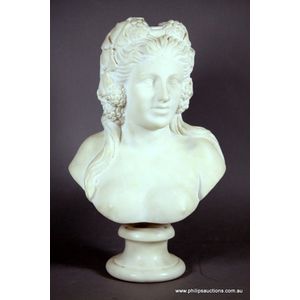Parian Busts: Apollo, Ajax, and Duke of Wellington
You must be a subscriber, and be logged in to view price and dealer details.
Subscribe Now to view actual auction price for this item
When you subscribe, you have the option of setting the currency in which to display prices to $Au, $US, $NZ or Stg.
- Socle - The short plinth, usually cylindrical, that serves as a pedestal for a sculpture or vase
- Art Union of London - Art Unions were organisations that functioned to promote and fund works of art. The members would pay an annual subscription, which would be used to purchase works of art, and these would then be distributed among its members by means of a ballot.
The Art Union of London was established in 1837 and by the 1840s was distributing art to the value of £9,000 each year.
The works purchased ranged from paintings which had been exhibited at the Royal Academy and in galleries to prints and smaller pieces including commissioned Parian wares, medals and bronze statuettes.
The membership numbers of the Art Union of London remained strong until the 1890s when they began to decline, and the Union was wound up in 1912. - Apollo - Apollo is the Greek and Roman god of the sun, and patron of music and poetry. He is often depicted with a lyre.
- Dexter - The words dexter and sinister are commonly used in heraldry, but have a more general application in the world of antiques and collectables (mainly sculpture and numismatics) to describe the position of the head of the subject. Dexter, which is Latin for right means the subject is looking to their right, while sinister, which is Latin for left, means the subject is looking to their left.
- Sinister - The words dexter and sinister are commonly used in heraldry, but have a more general application in the world of antiques and collectables (mainly sculpture and numismatics) to describe the position of the head of the subject. Dexter, which is Latin for right means the subject is looking to their right, while sinister, which is Latin for left, means the subject is looking to their left.
This item has been included into following indexes:
Visually similar items

A Victorian Parian bust, the head of Apollo, on socle base. Provenance: The Flower Family Collection. Height 28 cm

Copeland parian bust of Princess Alexandria, c.1863, realistically modelled and finely detailed, impressed to back 'Published Feb 1 1863/ Copeland/ Crystal Palace Art Union/ F. M. Miller Sculpt', Height 31 cm

Copeland parian ware bust - Art Union of London 1861

An antique marble bust of a classical woman, 19th century. the white marble bust of a classical allegorical woman her hair tied with ivy and clusters of fruit; unmarked. Height 42 cm
